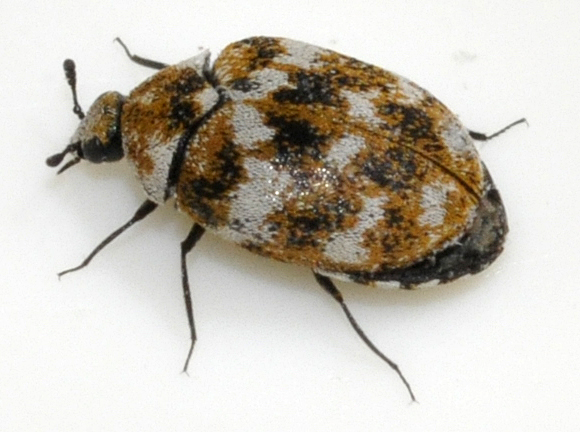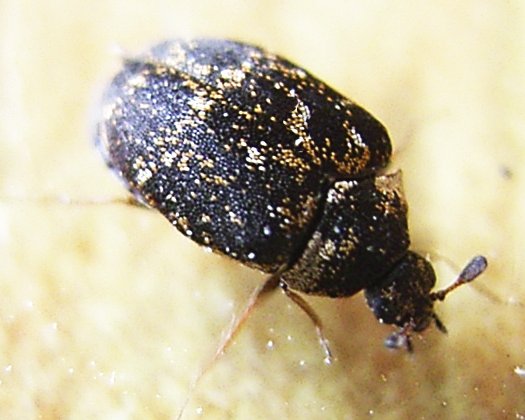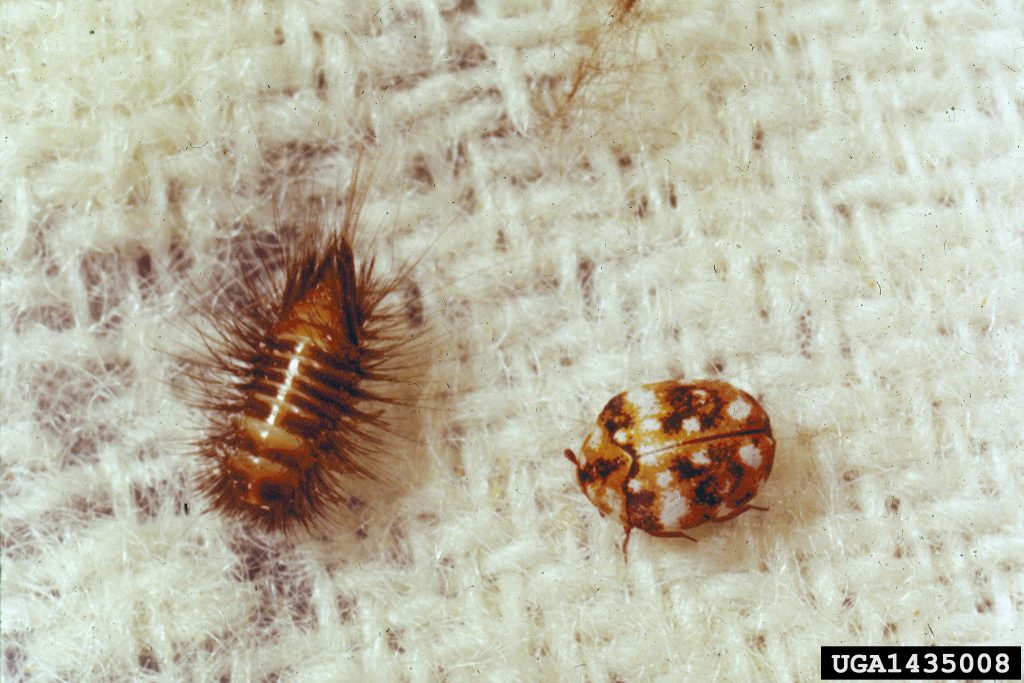Carpet beetles are small, pesky insects that can wreak havoc on households across the United Kingdom. While their size may be deceptive, the damage they cause to carpets, fabrics, and belongings can be substantial. In this comprehensive guide, we will delve into the world of carpet beetles, offering detailed insights into:
- Identifying infestations
- Understanding what’s attracting them
- Eradicating them effectively
- Preventive measures
What causes carpet beetle infestations
Like most pests, carpet beetles are attracted to food sources. Searching for food is the most common reason carpet beetles will enter your building, but there are other attractants to watch out for. In this section, we’ll cover what might attract carpet beetles to your property.
Attracted to Natural Fibres: Carpet beetles are drawn to natural fibres like wool, silk, cotton, and fur, commonly used in carpets, clothing, upholstery, and other household items. If your home contains many of these materials, it may attract carpet beetles.
Poorly Stored Fabrics: Leaving clothing, blankets, and other textiles in storage for extended periods without proper sealing can provide an ideal environment for carpet beetles to infest. They can easily find their way into closets, drawers, and wardrobes, where these items are stored.
Animal Products: Carpet beetles are attracted to animal-based products like feathers, fur, and leather. If you have decorative items or upholstery made from these materials, they could attract carpet beetles.
Food Residues: Carpet beetles can also be attracted to food residues, especially those containing natural fibres like cereals, pet food, and crumbs. Poor kitchen hygiene or food spillage can entice them into your home.
Openings and Cracks: Carpet beetles can enter homes through small openings and gaps around windows, doors, and vents. They can also be carried inside on clothing or through open windows and doors.
Indoor Plants: Some carpet beetle species are attracted to pollen and nectar from indoor plants, making them more likely to enter homes with abundant plant life.
Light Attraction: Adult carpet beetles are often attracted to light sources at night, which can inadvertently draw them indoors. These creatures have wings, and they can fly!
Outdoor Infestations: If there is a carpet beetle population near your home, they may be much more prone to finding their way inside when searching for new food sources or shelter, purely because it’s nearby and convenient.
Poorly Maintained Carpets: Dust and debris accumulated in carpets provide a food source for carpet beetle larvae, making them more likely to infest the area.
Identifying Carpet Beetles
Before diving into eradication and prevention strategies, it’s essential to accurately identify carpet beetles. These insects typically measure between 1.5 to 4mm in length and come in various species, including the varied carpet beetle (Anthrenus verbasci) and the furniture carpet beetle (Anthrenus flavipes). Both species are commonly found in British households and businesses.
Carpet beetles have an oval-shaped body, and their colouration may vary. The varied carpet beetle exhibits a mix of white, black, and orange scales, while the furniture carpet beetle sports a more uniform black colour with yellow scales on its wings. Additionally, adult carpet beetles have six legs, compound eyes, and two antennae.
Below are some photos to help you understand if you have a carpet beetle infestation.


Signs of Infestation
Spotting signs of a carpet beetle infestation is crucial for timely intervention. Common indicators include:
Damage to Fabrics: Carpet beetles feast on natural fibres like wool, silk, and cotton. Look for irregular holes or damaged areas on carpets, clothing, and upholstered furniture. The damage caused by carpet beetles is very similar to that caused by carpet moths, so check out this article on carpet moths if you’re not sure which one is chewing up your carpets. In addition to damaged carpets, you should look for a second sign of infestation to help confirm that you have a beetle problem.
Shed Skins: As carpet beetles go through their life cycle, they shed skins or exuviae. These small, brownish shells can often be found near infested areas.
Larvae Presence: The larvae are the most destructive stage of carpet beetles. They are small, carrot-shaped, and covered in bristles. They may be found crawling on the floor or burrowed into fabrics.
Adult Beetles: Spotting adult carpet beetles on windowsills or near windows can indicate an infestation.

Carpet Beetle Damage
Carpet beetles are known for their diverse diet, feeding on various materials found in homes. These materials include wool, fur, silk, feathers, and pet hair. Consequently, a carpet beetle infestation can significantly damage carpets, clothing, curtains, and upholstered furniture.
Carpet beetles pose a threat to cherished possessions and valuable items. If left unchecked, their destructive feeding habits can ruin textiles and fabrics, leading to costly replacements or repairs.
Getting Rid of Carpet Beetles
Upon discovering a carpet beetle infestation, swift action is necessary to prevent further damage. Follow these steps for effective eradication:
Inspection: Thoroughly inspect all areas suspected of infestation. Focus on carpets, wardrobes, and dark corners where larvae might hide.
Isolate Infested Items: Remove and isolate infested fabrics and belongings to prevent the spread of carpet beetles.
Vacuuming: Vacuum the entire affected area meticulously, including carpets, curtains, and furniture, with a machine capable of high-powered suction. Pay close attention to cracks and crevices where larvae might be hiding. It’s important to be thorough if you want to not only get rid of them but to prevent reoccurrence.
Washing & drying: Launder-infested clothing and fabrics at a high temperature to eliminate larvae and eggs effectively. It would be best if you were aiming to expose the beetles to 50 degrees Celsius for a period of no less than 30 minutes to ensure they have been destroyed. Not all fabrics can be washed at this heat, so you can choose to tumble dry fabrics instead at high heat (without washing them first). Always check the label of fabrics for specific guidance.
Freezing: For items that cannot be washed or dried, consider freezing them in a plastic bag for several days to kill any hidden carpet beetle larvae.
Chemicals: Various chemical insecticides are available online or in stores. While most will effectively control an infestation, using chemicals in one’s home isn’t ideal, particularly if you have pets or kids running around. One common control method is mothballs. Moth balls contain either naphthalene or paradichlorobenzene, both of which are toxic to humans if inhaled.
Natural Remedies
For environmentally-conscious individuals or those with concerns about using chemical pesticides, several natural remedies and non-toxic solutions can help combat carpet beetles:
Diatomaceous Earth: This natural, fine powder effectively kills carpet beetles and other pests. It dehydrates them, leading to their demise.
Essential Oils: cedar and eucalyptus have repellent properties that deter or kill carpet beetles. Soaking cotton wool balls in cedar oil and placing key areas can be a great way to control a carpet beetle infestation.
Sticky Traps: Placing sticky traps around infested areas can help catch adult carpet beetles, reducing their population.
The most effective components of any non-toxic DIY solution to getting rid of carpet beetles will involve thorough vacuuming and heating things via a tumble dryer.
Professional Pest Control Services
In severe infestations or if DIY methods prove ineffective, seeking assistance from professional pest control services may be necessary. Experienced exterminators can accurately assess the extent of the infestation and implement targeted treatments to eliminate carpet beetles effectively.
Good pest control companies can offer powerful, non-toxic solutions, such as whole room heat treatment.
Whole-room heat treatment is when a specialist system of industrial heaters is used to pump heat into a room quickly to bring the room above 50 degrees Celsius and to maintain that temperature evenly in all parts of the room to ensure nothing survives.
Preventing Carpet Beetles
Preventive measures are crucial to keeping carpet beetles from returning to your home. Implement the following strategies:
Proper Storage and Maintenance: Regularly clean and maintain clothing, fabrics, and textiles that are made of natural materials. Store them in airtight containers or vacuum-sealed bags to prevent infestations.
Clean and Declutter: Regularly clean and vacuum your home to remove dust, pet hair, and debris, which may attract carpet beetles.
Seal Entry Points: Inspect doors, windows, and other potential entry points, sealing any gaps to prevent carpet beetles from infiltrating your home. Keep windows closed to prevent beetles from entering, and avoid walking on carpets with shoes to prevent bringing carpet beetles into the home from outside.
Safeguarding Your Home
Protecting your home from carpet beetles requires specific actions for various areas:
Carpets and Furniture: Vacuum carpets regularly and steam clean them at least once a year. Use protective covers for furniture to prevent infestations.
Clothing and Fabrics: Store clothing in sealed containers and wash them before storing them for extended periods.
Long-term Storage: When storing items for an extended period, consider using vacuum-sealed bags and adding a few drops of essential oils for added protection.
Maintaining a Carpet Beetle-Free Home
Maintaining a carpet beetle-free home requires vigilance and regular inspections:
Regular Monitoring: Check susceptible areas regularly for any signs of carpet beetles or their damage.
Early Intervention: If you spot any signs of carpet beetles, take immediate action to prevent further infestations.
Quick Response: Act swiftly if you detect a resurgence of carpet beetles using a combination of eradication methods.
Be sure to contact us if you’d like some professional help. We offer coverage 24 hours across the entire UK and Ireland.

